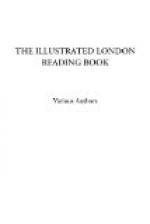Having reached its destination, and been detached or “unlimbered” from the front carriage, we next see the action of loading; the ramrod having at its other extremity a sheep-skin mop, larger than the bore of the piece, and called “a sponge.” This instrument, before loading, is invariably used, whilst the touch-hole or “vent” is covered by the thumb of the gunner especially numbered off for this important duty; and the air being thus excluded, the fire, which often remains within the bore, attached to either portions of cartridge-case or wadding, is extinguished. Serious accidents have been known to occur from a neglect of this important preliminary to loading; as a melancholy instance, a poor fellow may be seen about the Woolwich barracks, both of whose arms were blown off above the elbow joint, whilst ramming home a cartridge before the sponge had been properly applied.
[Illustration: LOADING.]
[Illustration: FIRING IN RETREAT.]
If it is deemed essential to keep up a fire upon the enemy during a temporary retreat, or in order to avoid an overwhelming body of cavalry directed against guns unsupported by infantry, in that case the limber remains as close as possible to the field-piece, as shown in the Engraving above.
Skilful provisions are made against the various contingencies likely to occur in action. A wheel may he shattered by the enemy’s shot, and the gun thereby disabled for the moment: this accident is met by supporting the piece upon a handspike, firmly grasped by one or two men on each side, according to the weight of the gun, whilst a spare wheel, usually suspended at the back of “the tumbril,” or ammunition waggon, is obtained, and in a few moments made to remedy the loss, as represented above.
[Illustration: DISABLED WHEEL.]
[Illustration: DISMANTLING A GUN.]
The extraordinary rapidity with which a gun can be dislodged from its carriage, and every portion of its complicated machinery scattered upon the ground, is hardly to be believed unless witnessed; but the wonder is increased tenfold, on seeing with what magical celerity the death-dealing weapon can be put together again. These operations will be readily understood by an examination of the Illustrations. In that at the foot of page 175 the cannon is lying useless upon the earth; one wheel already forms the rude resting-place of a gunner, whilst the other is in the act of being displaced. By the application of a rope round the termination of the breech, and the lifting of the trail of the carriage, care being previously taken that the trunnions are in their respective sockets, a very slight exertion of manual labour is required to put the gun into fighting trim. That we may be understood, we will add that the trunnions are the short round pieces of iron, or brass, projecting from the sides of the cannon, and their relative position can be easily ascertained by a glance at the gun occupying the foreground of the Illustration where the dismantling is depicted. To perform the labour thus required in managing cannon, is called to serve the guns.




